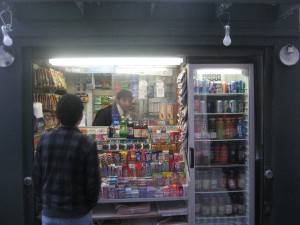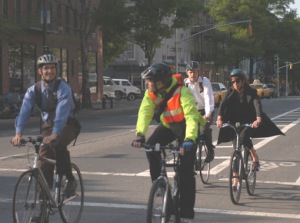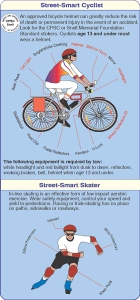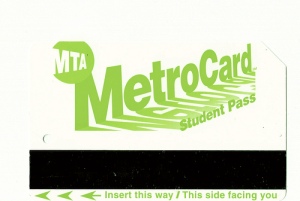It’s just past midnight on a cold Sunday and Soomin Lee, 22, is standing in his kitchen in Peter Cooper Village, sipping a tall glass of whiskey and making an extravagant version of macaroni and cheese. He is slim, tattooed, and baby-faced, with a red bandana holding back his long, shaggy hair. Sweating slightly, he begins emulsifying his rue (thickening a sauce by adding milk). Besides his faded black sweatshirt, tight blue jeans, and impish grin, Soomin looks like a stereotypical chef: Briskly and almost violently lifting, shifting, and whirling the large pan over a high sparking flame, he mumbles to himself, wiping his brow, tasting and stirring repeatedly. Suddenly, he drops the pan and begins darting from one corner of his kitchen to the next, rapidly dicing an entire onion into tiny identical cubes, reaching his hand into boiling water to try grab a noodle, popping it into his mouth while simultaneously pouring wine and milk and butter into the sizzling pan.
Soomin doesn’t measure—or even seem to think—before he adds one ingredient after the other. “I eye it out” he explains, “that’s thing about the professional kitchen, you tend to repeat yourself so much that you memorize the recipes, and then you stop fucking referring to them. At first it’s all chemistry, it’s a science. Plus we’re constantly tasting, all day long. But [we] learn to just know when its done.” Cocking his head to the side, he pours the sauce into the bowl of steaming noodles. “But judgment and timing is one of the hardest things to learn” he admits.
He pauses to gulp down the glass of whiskey, wink, and examine his work. “Oh yeah” he shakes his head and moans, “Look at that glaze! Look at that pure sexiness. That is one fucking sexy sauce.”
I sit beside friend Hawk Donofrio, 21, and watch in awe as Soomin adds his final touches to the meal, then pours two glasses of red wine (and another large whiskey for himself) and serves us in one swoop. “Dude!” Hawk exclaims, “It’s like you have five hands!” to which he simply chuckles and responds, “Dig in.”
Rather than sit with us, Soomin jumps up onto the kitchen counter, bowl in hand. But he doesn’t eat immediately—first, he studies both of our expressions as we take the first bite. I hum in satisfaction. Hawk smiles, shaking his head slowly, licking his lips. Soomin smiles shyly, lowers his eyes, and begins to eat.
Soomin Lee is the youngest and most inexperienced cook in the four star French bistro, Bar Baloud, located on 64th and Broadway. But this hasn’t stopped him from moving up in the culinary world: he has been promoted twice within the past six months, offered three jobs (with double the salary to encourage him to leave his current position), and is presently collaborating with an international business owner to open his own restaurant within the next five years.
But he has been interested in food long before he went to the Institute of Culinary Education, (ICE) on 23rd between 6th and 5th avenue. His earliest memory is of eating a fresh oyster on the beach. He was four when he first lifted a pan. “My grandmother is from old world Korea, and she would have to cook for the family,” he says, “so she taught me how to cook when I was a very little kid. But she’s old fashioned, and it wasn’t really ever a plan for me to eventually become a professional cook or a chef. [But] I kept experimenting all through childhood, and would always cook for myself and for the family whenever I could…”
“She hated when I made dumplings,” he continues, grinning “it was a woman’s job, a time to gossip and talk with the other girls in the family. But I started really enjoying learning about [cooking] and practicing, and I’d get addicted to recipes, and eventually it turned into this career, which I love.”
Suddenly Soomin’s features change, sharpen; more seriously and with emphasis, he adds “I love physical jobs: I was a messenger, a drummer, I worked in a printing press. I love the idea of applying myself to something that has such direct effect on people, gives them such pleasure. And at the same time I get exactly what I want out of it, and it’s very rewarding. And I love cooking. I love creating through it. I think it’s an incredible medium.
Glancing up at me, almost nervously, he continues “And it’s craft before its art. But I really like the idea that you can apply [art] to it. I mean, you eat with your eyes, your nose, even your ears. And in that respect I think its one of the greatest potential art forms.”
He believes that experiencing cuisine involves more than the food, but the service, the environment, and the atmosphere all of which are, according to Soomin, “meant to give you bodily pleasure, in every sense.”
Still, kitchen life is hectic, consuming, and dangerous. Cooks endure grueling 10-12 hour shifts without breaks, 6 days a week. Pay is low: Line cooks typically make $19,000 to 25,229 a year, sous-chefs and executive chefs make between $25,000—50,000. Bar Baloud, owned by the legendary Daniel Baloud (“the God of contemporary French cooking in America.”) is particularly hectic. Soomin describes the pressure of his job with a mix of exasperation and conceit. “Everyone knows we put up the highest numbers…” he explains, “It’s the craziest place on the planet! Well—as far as restaurants go.”
Today, Soomin completed a 14 hour double shift, severed his right index finger to the nail, and is running on less than four hours of sleep. He begins work tomorrow at 6 A.M. Nonetheless, he is oddly energetic and upbeat. “I got tagged today!” he says, a manic energy flashing in his eyes. “Wanna see?” Before I have time to answer, he rolls his sleeves up and reveals the latest “tag,” or burn, among a jagged array of light pink and deep brown scars. One ropes wildly around his entire wrist, another forms a perfect crater of cauterized flesh just below his elbow. He pokes at the bleeding knife wound absently and mumbles, “I should probably get around to super-gluing this one closed.”
But Soomin doesn’t seem to mind the way his arms look, claiming ” it’s part of the job.” Many of the burns originate from the same kitchen-ware and are therefore identical in location, size, and shape. Because of this, a chef can often spot another chef almost immediately. “But “Most people probably think I’m some sort of nutso masochist…” he giggles. “I’m lucky it’s only my arms, not my face or my balls yet.” (Often, coworkers burn their lower regions when accidentally leaning into flat plates that reach 670 degrees) Later, I overhear him telling Hawk about a female pastry chef who “smoldered her face” and never looked the same.
The worst injury he’s seen in the kitchen? “Once a chef severed the major tendon in his thumb when he was sharpening a knife carelessly” he pieces his thumb with an imaginary knife, “The knife went right through him. He just went into the emergency room, but he severed it so cleanly they couldn’t put it back together, and he still can’t use his thumb.”
Another time, a cook cut the entire tip of his pinky finger off, straight through the nail. He refused to go to the hospital, insisting there was no time. Instead, he threw the severed flesh away, heated a metal spoon, disappeared into the hallway, cauterized the wound, and got back to work. “Because we’re fucking busy” Soomin says simply and with hint of pride. “It’s like, do that, or get fired. Your choice.”
Physical injury is not the only downside of the job. Psychological melt-downs are not uncommon, especially at the infamously chaotic Bar Baloud. Two weeks ago the head saucier of five years suffered a mental breakdown and never came back in to work. On Monday, Soomin’s AM station (in charge of making cold dishes, soups, appetizers and prep) was serving 400 people. Halfway through, “some new kid screwed up and just broke down. Crouched on the floor in the fetal position and cried like a baby.” Soomin raises his eyebrows, pausing for emphasis, and takes a heavy drag from his third cigarette. “And everyone’s just running around this kid on the floor, you know? We don’t have time to stop and take care of him.” It’s hard to tell whether Soomin feels guilt or disbelief as he lowers his voice and adds: “And then Chef reaches down, takes the cell-phone out of his pocket and calls the kid’s mother. When she picks up, Chef just goes, ‘You wasted 60,000 dollars of college tuition on your son. He’s never going to make it as a chef. He’s fired.’ And hung up.”
He may not break down publically, but even strong-headed Soomin admits he isn’t impervious to the stress. His symptoms mimic those of a war veteran: He is jumpy, hyper, tense and angry. It usually takes him several hours and a few stiff drinks to wind down after work. Even on his rare days off, he worries about the kitchen, estimates how many customers are coming in, and calls to check in on coworkers. At night, if he can sleep, he wakes up sweating and feverish, frantically chopping imaginary beats and carrots in his bed.
So what exactly appeals to a cook like Soomin?
Part of it is the impermanence of the position. In the back of every cooks mind, there is a common goal to make it out of the kitchen, open up a restaurant, and finally put personal vision and creativity into his or her work.
“For now, I’m a cook, not a chef.” Soomin says, stating sternly “But like my chef Damien said to us the other day: if you’re not here to open up you’re own restaurant one day, the doors upstairs. You can fucking get out. Because we’re all here to start or to continue or finish our time serving somebody. So we can finally open our own place. And that’s why you’re a chef. Because you have to know it in order to run it.”
Ultimately, however, it’s his zeal for food and dedication to his kitchen that drive Soomin to succeed despite all obstacles. It’s a lifestyle and a passion most people will never fully be able to understand, but to Soomin, the pain and anxiety are worth the sense of joy cooking brings him. He believes firmly in putting love into everything he makes: “Love for the food, love for the art” he says. “And also love for your kitchen, because really, whether you like them or not, at the end of the day [they become] your family.” To him, compared to all other careers, professional cooking takes the most toll but reaps the most rewards. “The great thing about this is that it’s a very specific kind of happiness,” he explains, “because I’m detached from the people that I’m making happy. I can be an asshole behind closed doors. In the end you’re doing it for people that don’t know you exist, people you’ll never even see….I’ll never see them taste the food but I know exactly how they’ll feel when they do. And I love that.”
Of course, like most young adults, there are times when Soomin doubts his choices and his future: “I miss being in a band, I miss performing…I miss sunlight” he murmurs, smiling sadly. “But I know I’m going to become a chef and open up a restaurant well before I’m 30” Then, for the first time in our conversation, Soomin hesitates, wavers. “And that’s asking a lot, that’s asking a lot. That’s pretty bold and risqué thing to say.”
A moment later, he returns to normal: crooked smirk, eyes full of mischievous charm and beaming confidence. Almost to himself, he says, “But that’s how I do it—I fucking go until it’s done. I’m going to be the best. Just give me a few years.”
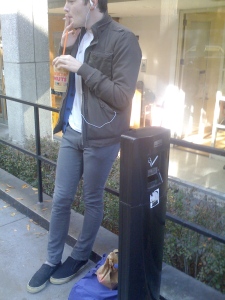 Why are New Students at the New School smoking?
Why are New Students at the New School smoking?





